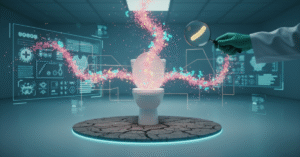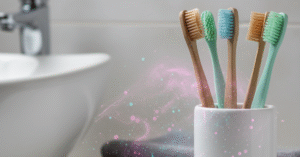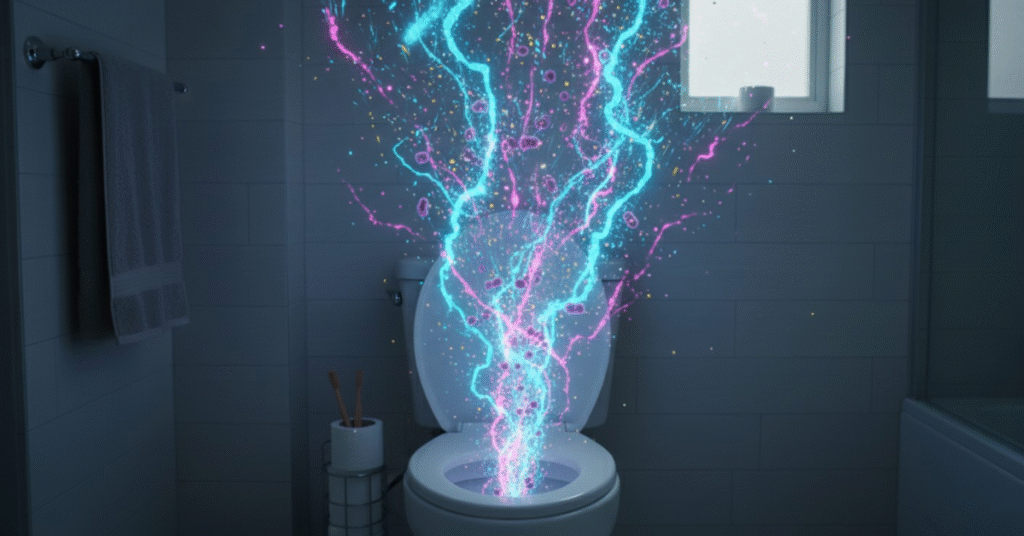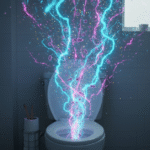What is toilet plume? It’s the unsettling scientific term for the invisible cloud of germ-carrying droplets that shoots out of your toilet bowl every time you flush with the lid up. Most people never think twice after pressing that handle, considering the job finished. But as a fact writer, I discovered the sheer scientific reality of the toilet plume—a hidden process that can spray tiny, invisible particles of potentially harmful material all over your bathroom. This phenomenon genuinely surprised me, and it’s a fact everyone needs to know. Let’s break down exactly what is toilet plume, why it’s a big deal, and the easy steps you can take right now to protect yourself and your family.
What is Toilet Plume: The Science of the Flush

At its core, the toilet plume is a cloud of invisible aerosols—super-fine droplets of water—that shoot up from the toilet bowl immediately after flushing. These droplets are created by the powerful turbulence of the flushing water mixing with the air above the bowl.
The important (and slightly gross) part is what these droplets contain. Since the water in the toilet bowl has just mixed with human waste (fecal matter and urine), the aerosol cloud carries minute particles, and yes, even airborne bacteria and viruses, from the bowl into the bathroom air.
Scientific studies, especially those conducted during and after the COVID-19 pandemic, have shown that these plumes can travel surprisingly far—sometimes reaching as high as 3 to 5 feet (about 1 to 1.5 meters) above the toilet seat. They can hang suspended in the air for minutes, even hours, before settling on nearby surfaces. Think about everything near your toilet: your toothbrush, towels, bathroom counter, and even your sink. Suddenly, that fast flush doesn’t seem quite so sanitary, does it?
The Distance Germs Travel
My own experience, after reading the detailed findings on the dispersal of these particles, completely changed my bathroom routine. I realized that the combination of a high-power modern flush and an open toilet lid is essentially a mini-bio-aerosol generator. Recent high-tech studies confirm that the plume can shoot particles up to 5 feet into the air. Studies confirm that knowing what is toilet plume is crucial, as the aerosol can travel across a standard bathroom.
Why You Should Care About Airborne Germs
The immediate question that comes to mind is: Is the toilet plume actually dangerous? The answer, according to health experts, is that it is a potential risk that should be taken seriously, especially in public or high-traffic bathrooms.
Research has confirmed that pathogens like E. coli, Salmonella, and the bacteria that cause C. difficile, as well as various viruses (including coronaviruses in some studies), can be aerosolized during a flush. While the risk of infection from a typical home bathroom is considered lower for healthy individuals, the potential for cross-contamination of surfaces is real.
The biggest takeaway here is awareness. Simply knowing what is toilet plume is the first step toward better bathroom hygiene.

Simple, Effective Solutions: The “Lid Down” Rule
Fortunately, the solution to mitigating the risk posed by the toilet plume is simple, free, and highly effective.
The Golden Rule: Put the lid down before you flush!
Putting the toilet seat lid down creates a physical barrier that drastically reduces the amount of aerosolized material that escapes into the room.
Putting the toilet seat lid down creates a physical barrier that helps contain the larger, bacterial-carrying droplets. While older studies showed this drastically reduces contamination, newer viral studies suggest smaller particles can still escape through gaps around the lid. Therefore, the “Lid Down” rule is still a great first step, but it must be paired with other methods for complete protection.
Other Practical Hygiene Steps
Other practical steps for a cleaner, safer bathroom include:
- Storage: Keep toothbrushes, contact lenses, and any personal grooming tools stored inside a cabinet or covered container, especially if they are close to the toilet.
- Ventilation: Always turn on your bathroom fan (exhaust fan) before flushing and leave it running for several minutes afterward to help cycle the air out of the room.
- Cleaning: Regularly disinfect surfaces like the sink, counter, and floor around the toilet, as this is where the particles eventually settle.
- Deep Cleaning is Key: The most effective defense against the plume is regular disinfection. Scientists now confirm that cleaning the toilet bowl and all surrounding surfaces with a disinfectant is the best way to eliminate pathogens at their source, far more effective than just closing the lid alone.
In conclusion, while the thought of a cloud of microscopic particles spreading after every flush is undeniably unsettling, the knowledge of what is toilet plume empowers us to take a small, immediate action—closing the lid—to safeguard our personal spaces. It’s a classic example of a small habit having a huge positive impact on hygiene and health.






